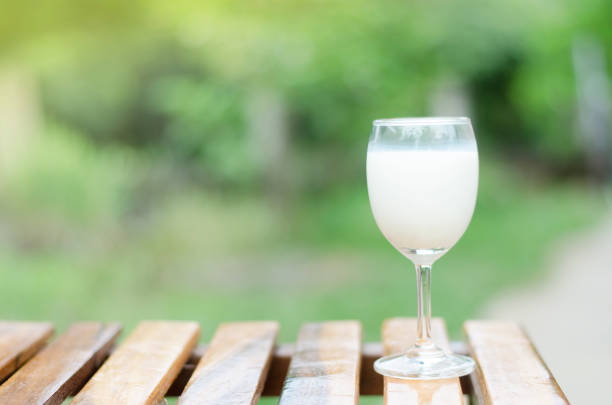Palm wine is a white, fermented sugary beverage that is obtained from the sap of several palm tree species.
The wine is popular in parts of West Africa, Asia, South America, and the Caribbeans where it is called Mmanya ocha (Igbo), Toddy (Asia), Tuba, Doka, Mimbo, and Vino de coyol.
It is slightly alcoholic when fermented and is famous for its perceived health benefits and cultural importance.
Among the Igbos of south-east Nigeria, it is used in traditional marriages to mark the beginning of married life between the bride and groom.
In other cultures, palm wine is mostly drunk for its carminative and lactation-boosting effects.
This article will provide you with evidence-based information on palm wine’s nutrition, benefits, and risks.
How is palm wine produced?
Palm wine is produced from the sap of palm trees by natural yeast fermentation.
The wine is extracted from different species of the Palmae family – oil palm, raffia palm, date palm, iron palm, and coconut palm. [1]
There are two methods of tapping the wine [2]; the first method is by draining the wine from the palm tree inflorescence. This is achieved by climbing onto the tree, making an incision, and attaching a clay pot or plastic container for the wine to drain out.
The second method involves uprooting the tree before making an incision on the trunk. A tube is then attached and connected to a clay pot or gourd. The sap gradually drains out.
This second method is often termed “destructive” as the tappers destroy large acres of vegetation in the process.
Interestingly, the fresh sap is rich in sucrose, sweet, and less alcoholic. But after 24 hours the sucrose level decreases by almost 50% because microorganisms act on the sap – converting it to wine. [3]
The whole process of fermentation takes about 48 hours to 72 hours.
Nutrition facts
The nutritional composition of palm wine varies according to location and palm tree species.
However, studies have found that the wine is rich in antioxidants, water, protein, fats, carbohydrates (sugars), vitamins, minerals, alcohol, and microorganisms.
One study found the following nutrients in 100 grams of wine obtained from the oil palm (Elaeis guineensis). [3]
- Sugars
- Maltose: 0.1 milligram (mg)
- Sucrose: 8 mg
- Protein (amino acids): 59 mg
- Fats: 62 mg
- Ethanol: 3 mg
Vitamin C, magnesium, phosphorus, and zinc were also found.
Additionally, palm wine contains an abundance of beneficial microorganisms such as yeast (Saccharomyces cerevisiae) and probiotic bacteria (Lactobacillus) that help in different stages of the fermentation process.
Health benefits of palm wine
The following are the possible health benefits:
Rich in antioxidants

Antioxidants are compounds that protect your body cells against free radicals, which play a role in heart disease, cancer, and other diseases.
Palm wine, especially fresh wine, is rich in phenols and vitamin C that help prevent oxidative damage and repair body cells. [4]
To get the full antioxidant benefits, drink freshly tapped wine that has not been diluted with water and artificial sweeteners.
Rich in probiotics
Palm wine is rich in acetic acid bacteria and lactic acid bacteria (Lactobacillus species) that both exhibit great probiotic activity.
Probiotics are “health-friendly bacteria” that exert numerous health benefits and boost the immune system.
Studies have found that probiotics may help prevent bowel diseases, heart disease, and diarrhea. [5]
Also, probiotic bacteria prevent the growth of harmful bacteria in the human gut.
Pro-tip: To get the full probiotic benefits, drink wine that has been fermented for at least 24 hours.
It may help strengthen immunity
Palm wine’s rich content of minerals, vitamins, protein, sugars, fats, and probiotics may help boost your immune system.
It can be considered a complete beverage drink and may help to build your body’s defense against diseases.
Some African traditional medicine experts believe that drinking this wine maintains eye vision, protects the skin against diseases, and helps strengthen male fertility.
However, more human studies are needed to fully understand its exact mechanisms.
May help promote lactation
Palm wine is largely believed to induce lactation for poorly lactating mothers in folklore medicine.
Most rural dwellers strongly believe that drinking freshly-tapped palm wine increases breast milk flow for newborn babies.
They understand that freshly tapped wine contains high amounts of nutrients that are good for the baby and mother.
However, due to the problem of adulteration, most women may be unknowingly downing large amounts of artificial sweeteners and alcohol that may not be too healthy for the newborn.
It May help reduce anxiety
Fermented palm wine may contain traces of alcohol and probiotics that may help calm anxiety attacks.
Recent studies have discovered that probiotics may help reduce anxiety by modulating sequences in the gut-brain axis. [5]
Although palm wine may act as a carminative, more scientific research is needed to determine the maximum alcohol and probiotic levels needed to achieve this effect.
Potential side effects of palm wine
The following are health concerns of drinking palm wine:
Diabetes

Due to its sugar and alcohol content, palm wine may not be suitable for regular consumption by diabetics. [4]
The sugar content is high while the alcohol content is low when the drink is freshly harvested. But the inverse happens as soon as fermentation progresses.
It would be helpful if commercial producers indicate the quantity of sugar and alcohol in each batch of products to help consumers make informed decisions.
Recommended: Diabetes diet: what to eat and what to avoid
Alcohol
Ethanol consumption in large amounts can harm the liver and cause infertility problems in men.
The ethanol content of the wine varies. The fresh sap contains less than 1% but increases up to 5% as soon as fermentation starts.
Studies have found that palm wine consumption in men may cause a decline in testicular function by decreasing testosterone levels, sperm motility, and sperm viability. [6]
So it is important, for men and lactating mothers, to know the exact amount of alcohol in each batch.
Recommended: 10 proven Herbs for low Sperm Count and Motility.
Adulteration
Intentional and unintentional adulteration of the wine with foreign materials is the biggest health concern in the consumption of palm wine.
One study found high levels of potentially dangerous chemicals (benzene, styrene) in one batch of palm wine. [7]
Leaves, stems, and bark can also get into the palm wine during the tapping process.
Other methods of adulteration involve; diluting the product with large amounts of untreated water and incorporating artificial sweeteners.
Therefore, public health personnel must regulate the preservation methods, storage containers, and hygiene practices involved with the production.
Insect contamination
After harvesting palm wine, dead flies or bees may be seen floating on the surface. This has led to concerns of pathogenic contamination by dead insects.
Other animals like bats, birds, and squirrels may also try to contaminate the fresh sap by drinking and passing excreta into the wine during tapping.
This can be loosely prevented by placing a mesh or net that will prevent insects and animals from accessing the wine. [4]
The bottom line
Palm wine is a delicious beverage with lots of antioxidants, probiotics, and nutrients.
It’s also greatly beneficial to health, as it helps boost immunity, promote lactation, and prevent anxiety attacks.
However, more research is needed to determine the best production and preservation techniques that will ensure that the beverage is healthful for consumption.
- Djeni et al. Microbial Diversity and Metabolite Profiles of wine Produced From Three Different Palm Tree Species in Côte d’Ivoire. Sci Rep 10, 1715 (2020).
- Amoa-am et al. Growth of yeasts, lactic and acetic acid bacteria in wine during tapping and fermentation from felled oil palm (Elaeis guineensis) in Ghana. Journal of Applied Microbiology.
- Ezeagu and Fafuunso. Biochemical constituents of palm drink. researchgate.net/publication/ Biochemical constituents of palm
- Nwaiwu and Chikezie. Suitability of Palm drink as a Multi-Functional Beverage. researchgate.net/publication/ Suitability of wine as a Multi-Functional Beverage
- Shi, Lye Huey et al. Beneficial Properties of Probiotics. Tropical life sciences research vol. 27,2 (2016)
- Oyedeji et al. (2012). Effect of palm drink on reproductive functions in male Albino rats. Res J Biol Sci 7:340-44
- Nwaiwu and Itumoh. Chemical Contaminants Associated with Palm drink from Nigeria Are Potential Food Safety Hazards. https://www.researchgate.net/publication/
Get new free and exclusive health tips delivered straight to your inbox!



